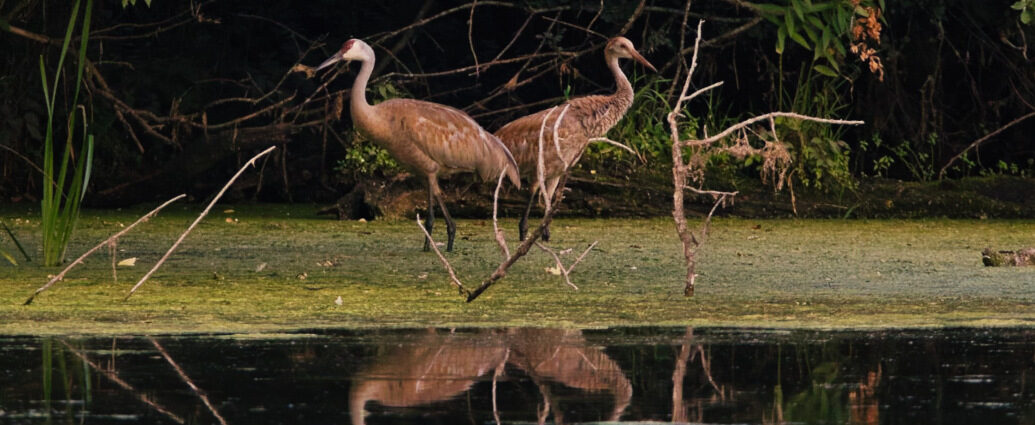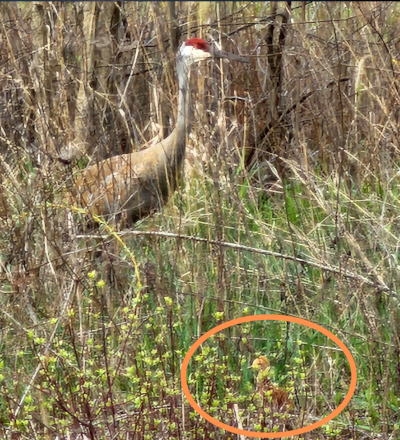
Sandhill cranes have made their return back to Southern Wisconsin thanks to conservation efforts by Southern Wisconsin Land Conservancy.
Brodhead, Wisconsin. August 2024. Southern Wisconsin Land Conservancy: Sandhill cranes raise a successful clutch of twins onsite at Three Waters Reserve. This is the first documented return of Sandhill Cranes to the property in over a century, resulting from conservation efforts and land restoration the site has undergone in the past six years.
Saturday, March 23rd, 2024 was a beautiful crisp morning with the air full of the calls of migratory birds moving north for the spring. Unseasonably warm weather triggered the move north early for many wildlife species, where early nesting signifies a reaction to the phenological change. An avid birder and former Board Member for the Wisconsin Society for Ornithology, Quentin Yoerger, was walking the trails at Three Waters Reserve when he spotted a Sandhill Crane nesting on site and reported it to Reserve staff.
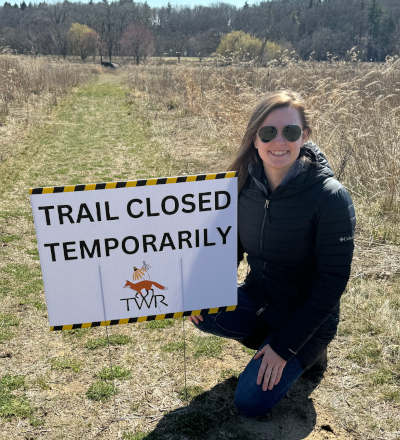
Having spent the last century as the Decatur Lake Country Club and Golf Course, the land at Three Waters Reserve has undergone significant ecological restoration. These changes have improved the native landscape enough to now support the return of these prehistoric creatures. The oldest known fossil of a Sandhill Crane is dated to be 2.5 million years old.
The landscape of the Reserve is the perfect habitat for Sandhill Crane nesting as they stake out land that is an open wetland surrounded by trees. Staff went quickly to work by temporarily closing trails around the nesting site, creating land management plans to give the cranes proper space during nesting (mom and dad get very territorial with their nest and babies), consulting with crane experts from the region, and collecting data for our onsite Field Station to further the research that is being conducted at the Reserve.
To our surprise, we were able to identify and observe not one, but TWO eggs in the nest. An Average clutch ranges from 1-3 eggs in size and typically only one egg survives and hatches.
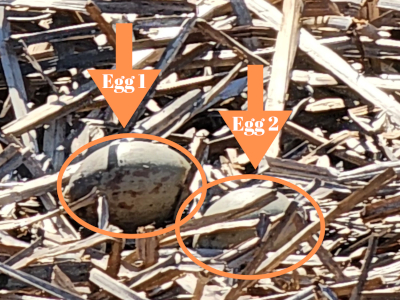
While cranes are experts at finding their ideal habitat with standing water to protect themselves from predators, it had us holding our breath as we watched the carefully chosen nesting site rise and fall with the weather patterns.
After consulting with experts from the International Crane Foundation, we continued to monitor the family from a distance and began counting down the days to the anticipated hatch date. Sandhill Crane eggs are approximately 3.6 inches long and 2.3 inches wide. They range in color from olive to pale brown, with brown markings. The incubation period lasts between 29 and 32 days.
Tracking the incubation period, we kept our eyes peeled and ears open for any crane activity. Each morning arriving at the Reserve for work, SWLC President Steve Apfelbaum would listen and hear the unison call sent out by the cranes.
Sandhill Cranes make over 20 different vocalizations to communicate a variety of different needs and situations. This unison call is unique, made not only to protect their territory but also to strengthen their bond with one another. The sound from this unison call can travel up to 2.5 miles and is reminiscent of prehistoric wildlife.
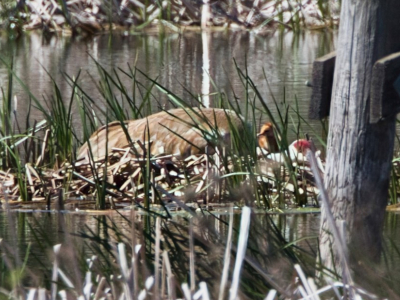
Wildlife photographer Craig Ellefson was visiting the Reserve and was lucky enough to witness the parent sitting on the nest with a colt, a baby crane, at its side. We were able to observe the parents with binoculars with TWO hatched, healthy, and active colts.
Within 8 hours of hatching, colts are able to not only walk, but can swim! Within a day of hatching, the twins transitioned to land with the parents! This was an important step for safety and food sourcing for the twins to survive.
Throughout the summer, we had sporadic sightings of the twins and the parents. The tall grasses at The Reserve serve as the perfect refuge for the colts and the parents. If the parents sense danger, an alarm call is sounded to nearby colts. The significance of this call is paramount to alert colts to drop into the grass and stop moving.
When we did spot red heads bobbing through the grasses, there was space between the parents. SLWC Board Member, Sue Faville, spent several years as a volunteer at the International Crane Foundation in Baraboo. While at ICF, Sue was a “Chick Mom” and offered insight into this behavior.
“In the case of twins when the food source is good, each parent with normally take a colt and strut around with it, teaching it to feed. If the food supply is scant, they will let one chick take over and both parents will feed the stronger of the two chicks resulting in the passing of the weaker one. It is sad, but that is nature. While volunteering as a chick mom at ICF, one of our responsibilities was to keep the colts from fighting with one another so they could all survive.”

We feel fortunate that the Reserve is a healthy ecosystem that enabled both twins to flourish.
Cranes begin to stage for migration south in November and typically leave for Florida by December. Sandhill Cranes typically travel 200-300 miles per day and up to 500 miles with the right winds. As the family grows and prepares for migration, we reflect, hoping they will remember their time here on the Reserve, and maybe this crane family will come back and visit us in the near future.
If you would like to support the conservation work done by the Southern Wisconsin Land Conservancy at Three Waters Reserve and other sites, please consider becoming an SWLC member, or make a donation at https://www.swconservancy.org/ Three Waters Reserve has trails that are open for free to the public daily from dawn to dusk.
You can reserve TWR for your next event at www.threewatersreserve.com, or you can attend one of our Friday Night Fish Fry’s at N3941 Golf Course Rd, Brodhead, WI 53520.
Writing By: Aryn Swann
Feature image sourced from Craig Ellefson

